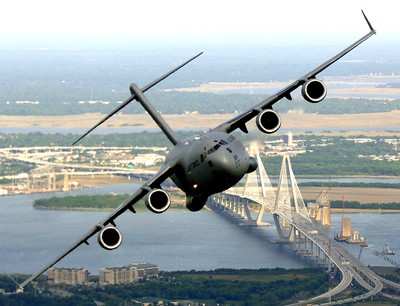‘Vortex Surfing’ At The Heart Of The $AVE Program
Air Mobility Command's chief scientist credited birds, dolphins and surfers for the success of recent ground-breaking C-17 Globemaster III flight tests expected to save the Air Force millions in annual fuel costs.

Dr. Donald Erbschloe flew aboard the test flights involving surfing aircraft vortices for energy - or "$AVE" - from Edwards Air Force Base, CA, to Joint Base Pearl Harbor-Hickam, Hawaii, and back, July 9-11. Later, he explained how nature provided inspiration for one C-17 aircraft to trail behind another and recapture energy that would otherwise be lost. This allows the trailing aircraft to use less fuel in a time when aviation fuel costs are soaring. Data from the tests promise savings of up to $10 million a year.
"Creatures in the wild do this all the time - exploiting conditions which give them an energetic advantage - just that slight edge," Erbschloe said. "Dolphins ... ride the 'bow waves' off ships, hawks circle in thermals to gain altitude and energy, and geese fly in V-shaped formations to reduce their exertion during long migrations."
He said during a recent ferry ride in Washington State, he mused at how seagulls employed the method. "I observed seagulls riding the air bow wave off the top of a ferry" Erbschloe said. "Just as we were starting our crossing, a seagull positioned itself and established a sustained glide. It never flapped its wings once during the entire 20-minute transit. Only when the ship slowed and maneuvered to dock did the bird start to fly on its own."
AMC aircrews and 412th Test Wing personnel, along with Boeing researchers, were on the two C-17 aircraft in the $AVE configuration. The July flights followed previous test flights at Edwards AFB in October, which proved the science behind the concept. Results from those tests were compelling enough to warrant the follow-on tests on an actual operational mission, which also included flying at night. "We were very pleased with the results of the long range demo. We demonstrated in-flight rendezvous, day and night operations, and flew several hours in each direction in our $AVE formation," said Bill Blake, the Air Force Research Laboratory $AVE program manager. "With only minor changes, we were able to attain double-digit fuel savings, which exceeded what we measured during our 2012 proof-of-concept test."
Erbschloe said other tests in years past involved fighter aircraft, which had to fly closely at "fingertip" intervals for any benefit, requiring a lot of pilot effort for what he described as "white-knuckle" flying; this is not the case with the larger C-17.
With minor software changes, the C-17's autopilot sustains the $AVE position at safe distances ranging from 3,000-6,000 feet between the lead and trailing aircraft, so the aircrew workload is minimal. He said in addition to confirming the fuel savings, assessing how $AVE affected the aircrew was an important part of these latest tests. "Maintaining position in the $AVE formation is no more task- saturating for the aircrew than flying at cruise on any other worldwide mission," said Maj. Kyle Clinton, the director of 62nd Airlift Wing weapons and tactics from Joint Base Lewis-McChord and one of the pilots who flew the trailing C-17 during the tests. "Across the board, I believe the potential benefits could be worthwhile for the aviation community - not just for C-17 formations but also for mixed formations, such as tankers (accompanying) fighters."
The tests are done, and the concept is validated. The next step involves funding for a DOD Advanced Technology Demonstrator to figure out the exact procedures and processes needed to introduce this fuel-saving concept to other Air Force aircraft. The two- to three-year project could begin as early as next year, Erbschloe said.
$AVE is the culmination of an ongoing, combined effort between AMC, the AFRL, the 412th TW, the Air Force Life Cycle Management Center, the Defense Advanced Research Projects Agency, the Boeing Company, and NASA Dryden Flight Research Center.
(C-17 pictured in AF file photo)
 Aero-News: Quote of the Day (11.17.25)
Aero-News: Quote of the Day (11.17.25) ANN's Daily Aero-Term (11.17.25): NonDirectional Beacon
ANN's Daily Aero-Term (11.17.25): NonDirectional Beacon NTSB Final Report: Fred L Wellman CH 750 Cruzer
NTSB Final Report: Fred L Wellman CH 750 Cruzer ANN's Daily Aero-Linx (11.17.25)
ANN's Daily Aero-Linx (11.17.25) Airborne-NextGen 11.11.25: Archer Buys Hawthorne, Joby Conforms, Stranded Astros
Airborne-NextGen 11.11.25: Archer Buys Hawthorne, Joby Conforms, Stranded Astros



